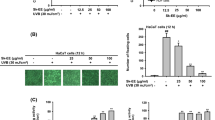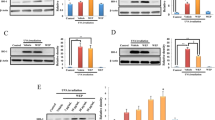Abstract
Sea buckthorn (Hippophae rhamnoides L.) seed, which has very high nutraceutical, cosmetoceutical and therapeutic properties, has been widely used to treat diseases in Tibetan and Mongolian traditional medicines. In this study, we measured the antioxidant activities of the solvent-dependent SBS (Sea buckthorn seed) extracts using the DPPH and Folin-Ciocalteu assays and we investigated the efficacy of SBS in protecting skin against UVB-induced damage using cultured human dermal fibroblasts. In addition, the inhibitory effects of SBS on UVB-induced skin photoaging were examined by determining the level of Metalloproteinase (MMP)-1 and procollagen after UVB-irradiation. The antioxidant capacity of the SBSE (alcoholic) extract was significantly higher than the SBSH (hexane) and SBSW (water) extracts, as measured based on the free-radical scavenging activity and total phenolic content. SBSE was chosen as the most suitable candidate antioxidant. In human dermal fibroblasts, the cell viability of SBSE extract at doses of 2.5, 5, and 10 μg/mL was higher than the UVB-treated control. By RT-PCR and Western blot, SBSE treatment inhibited UVB-induced IL-1β expression in cultured cells. In addition, SBSE restrained UVB-induced IL-6 and COX-2 gene expression in cultured fibroblasts in a dose-dependent manner. Treatment with the SBSE extract after UVB irradiation in human dermal fibroblasts significantly reduced MMP-1 expression and increased procollagen synthesis when compared with UVB-irradiation only. In this study, SBSE was shown to increase the synthesis of procollagen, decrease the expression of MMP-1, and inhibit the production of IL-1β, IL-6, and COX-2 in UVB-irradiated human fibroblasts. These findings suggest that the SBSE extract may be a potential therapeutic agent for preventing and treating skin photoaging.
Similar content being viewed by others
References
Gao, Z. L., X. H. Gu, F. T. Cheng, and F. H. Jiang (2003) Effect of sea buckthorn on liver fibrosis: A clinical study. World J. Gastroenterol. 9: 1615–1617.
Geetha, S., M. Sai Ram, V. Singh, G. Ilavazhagan, and R. C. Sawhney (2002) Antioxidant and immunomodulatory properties of sea buckthorn (Hippophae rhamnoides L.) — an in vitro study. J. Ethnopharmacol. 79: 373–378.
Gupta, A., R. Kumar, K. Pal, P. K. Banerjee, and R. C. Sawhney (2005) A preclinical study of the effects of sea buckthorn (Hippophae rhamnoides L.) leaf extract on cutaneous wound healing in albino rats. Int. J. Low. Extrem. Wounds. 4: 88–92.
Geetha, S. and G. Asheesh (2011) Medicinal and therapeutic potential of Sea buckthorn (Hippophae rhamnoides L.): A review. J. Ethnopharmacol 138: 268–278.
Xing, J., B. Yang, Y. Dong, B. Wang, J. Wang, and P. H. Kallio (2002) Effects of sea buckthorn (Hippophae rhamnoides L.) seed and pulp oils on experimental models of gastric ulcer in rats. Fitoterapia. 73: 644–650.
Kagliwal, L. D., S. C. Patil, A. S. Pol., R. S. Singhal, and V. B. Patravale (2011) Separation of bioactives from seabuckthorn seeds by supercritical carbon dioxide extraction methodology through solubility parameter approach. Sep. Purif. Technol. 80: 533–540.
Guliyev, V. B., M. Gul, and A. Yildirim (2004) Hippophae rhamnoides L.: Chromatographic methods to determine chemical composition, use in traditional medicine and pharmacological effects. J. Chromatography B. 812: 291–307.
Basu, M., R. Prasad, P. Jayamurthy, K. Pal, C. Arumughan, and R. C. Sawhney (2007) Anti-atherogenic effects of sea buckthorn (Hippophae rhamnoides L.) seed oil. Phytomedicine. 14: 770–777.
Negi, P. S., A. S. Chauhan, G. A. Sadia, Y. S. Rohinishree, and R. S. Ramteke (2005) Antioxidant and antibacterial activities of various sea buckthorn (Hippophae rhamnoides L.) seed extracts. Food Chem. 92: 119–124.
Marchioli, R., C. Schweiger, G. Levantesi, L. Tavazzi, and F. Valagussa (2001) Antioxidant vitamins and prevention of cardiovascular disease: Epidemiological and clinical trial data. Lipids 36: 53–63.
Vinson, J. A., X. Su, L. Zubik, and P. Bose (2001) Phenol antioxidant quantity and quality in foods: Fruits. J. Agr. Food Chem. 49: 5315–5321.
Chin, Y. W., M. J. Balunas, H. B. Chai, and A. D. Kinghorn (2006) Drug discovery from natural sources. AAPS J. 8: 239–253.
Chan, W. H., C. C. Wu, and J. S. Yu (2003) Curcumin inhibits UV irradiation-induced oxidative stress and apoptotic biochemical changes in human epidermoid carcinoma A431 cells. J. Cell. Biochem. 90: 327–338.
Morliere, P., A. Moysan, and I. Tirache (1995) Action spectrum for UV-induced lipid peroxidation in cultured human skin fibroblasts. Free Radic. Biol. Med. 19: 365–371.
Wang, X. Y. and Z. G. Bi (2006) UVB-irradiated human keratinocytes and interleukin-1α indirectly increase MAP kinase/AP-1 activation and MMP-1 production in UVA-irradiated dermal fibroblast. Chin. Med. J. 119: 827–831.
Ho, J. N., Y. H. Lee, J. S. Park, W. J. Jun, H. K. Kim, B. S. Hong, D. H. Shin, and H. Y. Cho (2005) Protective effects of Aucubin isolated from Eucommia ulmoides against UVB-induced oxida tive stress in human skin fibroblast. Biol. Pharm. Bull. 28: 1244–1248.
Seo, Y. K., J. K. Park, K. Y. Song, S. Y. Kwon, and H. S. Lee (2010) Wound healing effect of collagen-hyaluronic acid implanted in partially injured anterior cruciate ligament of dog. Biotechnol. Bioproc. Eng. 15: 552–558.
Huang, W. H., A. R. Lee, and C. H. Yang (2006) Antioxidative and anti-inflammatory activities of polyhydroxyflavonoids of Scutellaria baicalensis GEORGI. Biosci. Biotechnol. Biochem. 70: 2371–2380.
Cicco, N., M. T. Lanorte, M. Paraggio, M. Viggiano, and V. Lattanzio (2009) A reproducible, rapid and inexpensive Folin-Ciocalteu micro-method in determining phenolics of plant methanol extracts. Microchem. J. 91: 107–110.
Shin, Y. H., Y. K. Seo, H. H. Yoon, B. Y. Yoo, K. Y. Song, and J. K. Park (2011) Comparison of hair dermal cells and skin fibroblasts in a collagen sponge for use in wound Repair. Biotechnol. Bioproc. Eng. 16: 793–800.
Cho, J. S., H. W. Lee, S. J. Lee, and D. I. Kim (2007) Comparative proteomic analysis for hCTLA41g production in transgenic rice suspension cultures using two-dimentional difference gel electrophoresis. Biotechnol. Bioproc. Eng. 12: 333–339.
Rice-Evans, C. A., N. J. Miller, P. G. Bolwell, P. M. Barmley, and J. B. Pridham (1995) The relative antioxidant activities of plantderived polyphenolic flavonoids. Free Radic. Res. 22: 375–383.
Othman, A., A. Ismail, N. A. Ghani, and I. Adenan (2007) Antioxidant capacity and phenolic content of cocoa beans. Food Chem. 100: 1523–1530.
Seo, M. Y., S. Y. Chung, W. K. Choi, Y. K. Seo, S. H. Jung, J. M. Park, M. J. Seo, J. K. Park, J. W. Kim, and C. S. Park (2009) Anti-aging effect of rice wine in cultured human fibroblasts and Keratinocytes. J. Biosci. Bioeng. 107: 266–271.
Baggiolin, M., B. Dewald, and B. Moser (1997) Human chemokines: An update. Ann. Rev. Immunol. 15: 675–700.
Fisher, G., S. Datta, H. Talwar, Z. Wang, J. Varani, S. Kang, and J. Voorhees (1996) Molecular basis of sun-induced premature skin ageing and retinoid antagonism. Nature 379: 335–339.
Cho, S. Y., H. H. Kim, M. J. Lee, S. Lee, C. S. Park, S. J. Nam, J. J. Han, J. W. Kim, and J. H. Chung (2008) Phosphatidylserine prevents UV-induced decrease of type I procollagen and increase of MMP-1 in dermal fibroblasts and human skin in vivo. J. Lipid Res. 49: 1235–1245.
Junjing, Z., Z. Yan, and Z. Baolu (2010) Scavenging effects of dexrazoxane on free radicals. J. Clin. Biochem. Nutr. 47: 238–245.
Saka, A., M. Recio, R. M. Giner, S. Manez, H. Tournier, G. Schinella, and J. L. Rios (2002) Anti-inflammatory and antioxidant properties of Helichrysum italicum. J. Pharm. Pharmacol. 54: 365–371.
Blois, M. S. (1958) Antioxidant determinations by the use of a stable free radical. Nature 181: 1199–1200.
Chen, C. W. and C. T. Ho (1995) Antioxidant properties of polyphenols extracted from green and black teas. J. Food Lipids. 2: 35–46.
Archana, B., N. Dasgupta, and B. De (2005) In vitro study of antioxidant activity of Syzygium cumini fruit. Food Chem. 90: 727–733.
Zhang, L., A. S. Ravipati, S. R. Koyyalamudi, S. C. Jeong, N. Reddy, P. T. Smith, J. Bartlett, K. Shanmugam, D. G. Münch, and M. J. Wu (2011) Antioxidant and Anti-inflammatory activities of selected medicinal plants containing phenolic and flavonoid compounds. J. Agric. Food Chem. 59: 12361–12367.
Bajpai, V. K., J. I. Yoon, and S. C. Kang (2009) Antioxidant and antidermatophytic activities of essential oil and extracts of Magnolia liliflora Desr. Food Chem. Toxicol. 47: 2606–2612.
Kim, J. K., S. Mun, M. S. Kim, M. B. Kim, B. K. Sa, and J. K. Hwang (2012) 5,7-Dimethoxyflavone, an activator of PPARa?c, inhibits UVB-induced MMP expression in human skin fibroblast cells. Exp. Dermatol. 21: 211–216.
Gonzales-Castaneda, C., V. Rivera, A. L. Chirinos, P. Evelson, and G. F. Gonzales (2011) Photoprotection against the UVB-induced oxidative stress and epidermal damage in mice using leaves of three different varieties of Lepidium meyenii (maca). Int. J. Dermatol. 50: 928–938.
Adil, M. D., P. Kaiser, N. Satti, A. M. Zargar, R. A. Vishwakarma, and S. A. Tasduq (2010) Effect of Emblica officinalis (fruit) against UVB-induced photo-aging in human skin fibroblasts. J. Ethnopharmacol. 132: 109–144.
Fisher, G. J., S. Kang, J. Varani, Z. Bata-Csorgo, Y. Wan, S. Datta, and J. J. Voorhees, (2002) Mechanisms of photoaging and chronological skin aging. Arch. Dermatol. 138: 1462–1470.
Nowinski, D., A. Koskela, E. Kiwanuka, M. Bostrom, B. Gerdin, and M. Ivarsson (2010) Inhibition of connective tissue growth factor/CCN2 expression in human dermal fibroblasts by interleukin-1α and β. J. Cell. Biochem. 110: 1226–1233.
Liu, S., H. Mizu, and H. Yamauchi (2010) Photoinflammatory responses to UV-irradiated ketoprofen mediated by the induction of ROS generation, enhancement of cyclooxygenase-2 expression, and regulation of multiple signaling pathways. Free Radic. Biol. Med. 48: 772–780.
Author information
Authors and Affiliations
Corresponding author
Rights and permissions
About this article
Cite this article
Kim, H., Cho, H., Seo, YK. et al. Inhibitory effects of sea buckthorn (Hippophae rhamnoides L.) seed on UVB-induced Photoaging in human dermal fibroblasts. Biotechnol Bioproc E 17, 465–474 (2012). https://doi.org/10.1007/s12257-011-0548-y
Received:
Revised:
Accepted:
Published:
Issue Date:
DOI: https://doi.org/10.1007/s12257-011-0548-y




